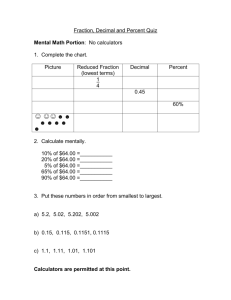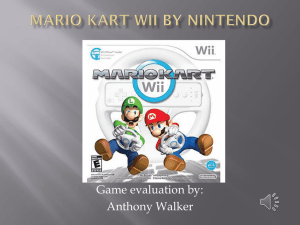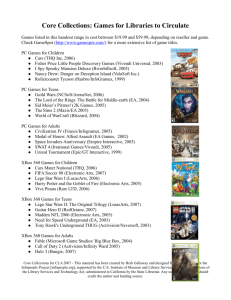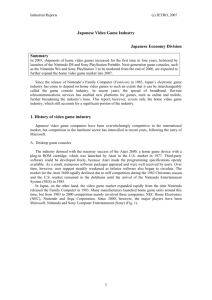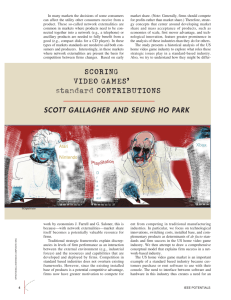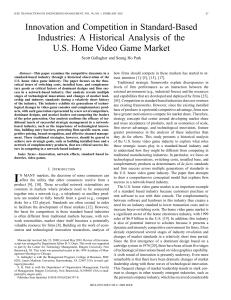Prelude case PS3 blues and X-box 360° turn as wee Wii wins
advertisement
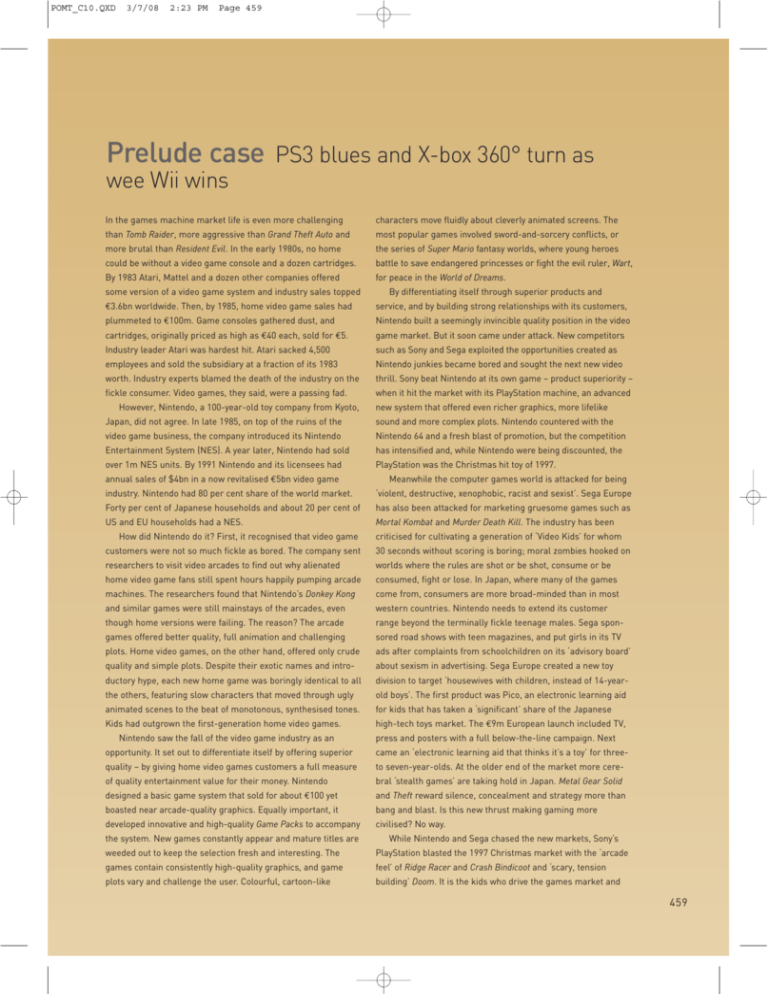
POMT_C10.QXD 3/7/08 2:23 PM Page 459 Prelude case PS3 blues and X-box 360° turn as wee Wii wins In the games machine market life is even more challenging characters move fluidly about cleverly animated screens. The than Tomb Raider, more aggressive than Grand Theft Auto and most popular games involved sword-and-sorcery conflicts, or more brutal than Resident Evil. In the early 1980s, no home the series of Super Mario fantasy worlds, where young heroes could be without a video game console and a dozen cartridges. battle to save endangered princesses or fight the evil ruler, Wart, By 1983 Atari, Mattel and a dozen other companies offered for peace in the World of Dreams. some version of a video game system and industry sales topped By differentiating itself through superior products and €3.6bn worldwide. Then, by 1985, home video game sales had service, and by building strong relationships with its customers, plummeted to €100m. Game consoles gathered dust, and Nintendo built a seemingly invincible quality position in the video cartridges, originally priced as high as €40 each, sold for €5. game market. But it soon came under attack. New competitors Industry leader Atari was hardest hit. Atari sacked 4,500 such as Sony and Sega exploited the opportunities created as employees and sold the subsidiary at a fraction of its 1983 Nintendo junkies became bored and sought the next new video worth. Industry experts blamed the death of the industry on the thrill. Sony beat Nintendo at its own game – product superiority – fickle consumer. Video games, they said, were a passing fad. when it hit the market with its PlayStation machine, an advanced However, Nintendo, a 100-year-old toy company from Kyoto, new system that offered even richer graphics, more lifelike Japan, did not agree. In late 1985, on top of the ruins of the sound and more complex plots. Nintendo countered with the video game business, the company introduced its Nintendo Nintendo 64 and a fresh blast of promotion, but the competition Entertainment System (NES). A year later, Nintendo had sold has intensified and, while Nintendo were being discounted, the over 1m NES units. By 1991 Nintendo and its licensees had PlayStation was the Christmas hit toy of 1997. annual sales of $4bn in a now revitalised €5bn video game Meanwhile the computer games world is attacked for being industry. Nintendo had 80 per cent share of the world market. ‘violent, destructive, xenophobic, racist and sexist’. Sega Europe Forty per cent of Japanese households and about 20 per cent of has also been attacked for marketing gruesome games such as US and EU households had a NES. How did Nintendo do it? First, it recognised that video game Mortal Kombat and Murder Death Kill. The industry has been criticised for cultivating a generation of ‘Video Kids’ for whom customers were not so much fickle as bored. The company sent 30 seconds without scoring is boring; moral zombies hooked on researchers to visit video arcades to find out why alienated worlds where the rules are shot or be shot, consume or be home video game fans still spent hours happily pumping arcade consumed, fight or lose. In Japan, where many of the games machines. The researchers found that Nintendo’s Donkey Kong come from, consumers are more broad-minded than in most and similar games were still mainstays of the arcades, even western countries. Nintendo needs to extend its customer though home versions were failing. The reason? The arcade range beyond the terminally fickle teenage males. Sega spon- games offered better quality, full animation and challenging sored road shows with teen magazines, and put girls in its TV plots. Home video games, on the other hand, offered only crude ads after complaints from schoolchildren on its ‘advisory board’ quality and simple plots. Despite their exotic names and intro- about sexism in advertising. Sega Europe created a new toy ductory hype, each new home game was boringly identical to all division to target ‘housewives with children, instead of 14-year- the others, featuring slow characters that moved through ugly old boys’. The first product was Pico, an electronic learning aid animated scenes to the beat of monotonous, synthesised tones. for kids that has taken a ‘significant’ share of the Japanese Kids had outgrown the first-generation home video games. high-tech toys market. The €9m European launch included TV, Nintendo saw the fall of the video game industry as an press and posters with a full below-the-line campaign. Next opportunity. It set out to differentiate itself by offering superior came an ‘electronic learning aid that thinks it’s a toy’ for three- quality – by giving home video games customers a full measure to seven-year-olds. At the older end of the market more cere- of quality entertainment value for their money. Nintendo bral ‘stealth games’ are taking hold in Japan. Metal Gear Solid designed a basic game system that sold for about €100 yet and Theft reward silence, concealment and strategy more than boasted near arcade-quality graphics. Equally important, it bang and blast. Is this new thrust making gaming more developed innovative and high-quality Game Packs to accompany civilised? No way. the system. New games constantly appear and mature titles are weeded out to keep the selection fresh and interesting. The While Nintendo and Sega chased the new markets, Sony’s PlayStation blasted the 1997 Christmas market with the ‘arcade games contain consistently high-quality graphics, and game feel’ of Ridge Racer and Crash Bindicoot and ‘scary, tension plots vary and challenge the user. Colourful, cartoon-like building’ Doom. It is the kids who drive the games market and 459 POMT_C10.QXD 3/7/08 2:23 PM Page 460 Part 3 Core strategy Exhibit 10.1 Peak sales of games consoles Peak sales year Format Games consoles Peak annual sales 1982 1989 1993 1997 2003 2006 Atari 8-bit 16-bit 32/64-bit 128-bit 256-bita Atari NES, Master System Megadrive/Genesis, SNES, 300 PlayStation, N64, Saturn PS2, X-box, Nintendo Game Cube, Dreamcast PS3, X-box 360, Nintendo Wii 10 m 11 m 14 m 32 m 45 m 34 mb a The new processors use new technology so the 256-bit description does not really apply. The PS3 has a ‘cell processor’ which boasts 35 times the power of the PS2. b Estimate based on cumulative sales to mid-2007 of PS3, X-box 360 and Wii. what they want is power and the latest cult machine. Three Nintendo argues that it has expanded the market to non- years after PlayStation blasted the competition, their €450 gamers who were put off by the complexity of modern games. PlayStation 2 (PS2) was aimed to do the same again for Sceptics argue that the Wii’s novelty will wear off, that the Wii Christmas 2000. With Internet access, CD and DVD playability, lacks the ‘high-definition’ graphics of its rivals and has only the PS2’s 128-bit microprocessor had twice the power of then- rudimentary online features. current PCs. So powerful was the PS2’s processor that its export Sony’s claim to leadership is based on its PS2 sales; the PS2 had to be specially licensed by the Japanese government since it actually outsold both the X-box 360 and the Wii in America had the performance necessary to guide a cruise missile. during December 2006. Its maker insists that the PS3’s rela- However, Sony did not have it all their own way. Sega launched tively modest sales – 2m units since November – are the result their Dreamcast a year before PS2 but sales were lacklustre and of supply shortages, though anecdotal evidence suggests that the machine and its games were soon discounted. The market PS3s are far easier to find than Wiis. Despite the PS3’s high also attracted the mighty Microsoft whose X-box appeared in late price – $499 (€368) and $599 (€442) in America, and €499 and 2001. Unlike other games machines, the X-box is intended for use €599 in Europe – Sony had to slash jobs as it posted record in a living room using the family TV and operating Microsoft’s PC losses. Concerned that the high price was putting buyers off, or products. Nintendo, too, is fighting back with their Game Cube. prompting them to wait for price cuts, it cut price by 20 per cent The battle between Sony, Microsoft and Nintendo pushed world games console sales to new heights in 2003 (Exhibit 10.1) in Japan and $100 in the US. Yoichi Wada, chief executive of Square Enix, one of Japan’s but worldwide sales for 2006 were forecast to be less than 10 leading game developers, thinks Microsoft and Sony have got it million. But that forecast did not stop an even bigger investment wrong. ‘Powerful next-generation consoles such as Microsoft’s for even better machines to gladden the hearts of game X-box and Sony’s PlayStation 3 are mismatched to the gaming players. The latest round began in 2005 with Microsoft’s X-box environment,’ he says, ‘and handheld game devices are set to 360. Then, in 2006 Nintendo’s Wii appeared while Sony launched dominate sales.’ He explains, ‘the demographics of gamers the PlayStation 3 (PS3). With the battle started, Microsoft, Sony have undergone a sea change in the past few years . . . There is and Nintendo all claim to be on top. a new breed of gamers in the market – we have to make games Microsoft boasts that it has sold the most consoles: 10m for all kinds of people.’1 X-box 360s since its launch. The 360 is popular in America and Europe, but is doing badly in Japan. The head start means that Questions the 360 has the best line-up of games, an important reason for choosing a console. Microsoft’s online service, Xbox Live, is also impressive, offering game and video downloads and allowing advanced and powerful machines when the market wanted gamers to play together online. entertainment? Nintendo boasts that its new console has taken off the fastest, having sold nearly 6m units. The low-cost Wii is proving so popular that it is still hard to come by months after its 460 1. Have Microsoft and Sony gone too far in creating more 2. What are the key ingredients for success in the computer games market? 3. Using information from the case, and your own knowledge, launch, and is generating by far the most buzz. In part this is compare the competitive strengths and weaknesses of the because the Wii’s motion-sensitive controller means even non- competitors in the computer game machine market. Who do gamers can quickly start playing tennis, golf or bowling. you think will be the long-term winners and why?
